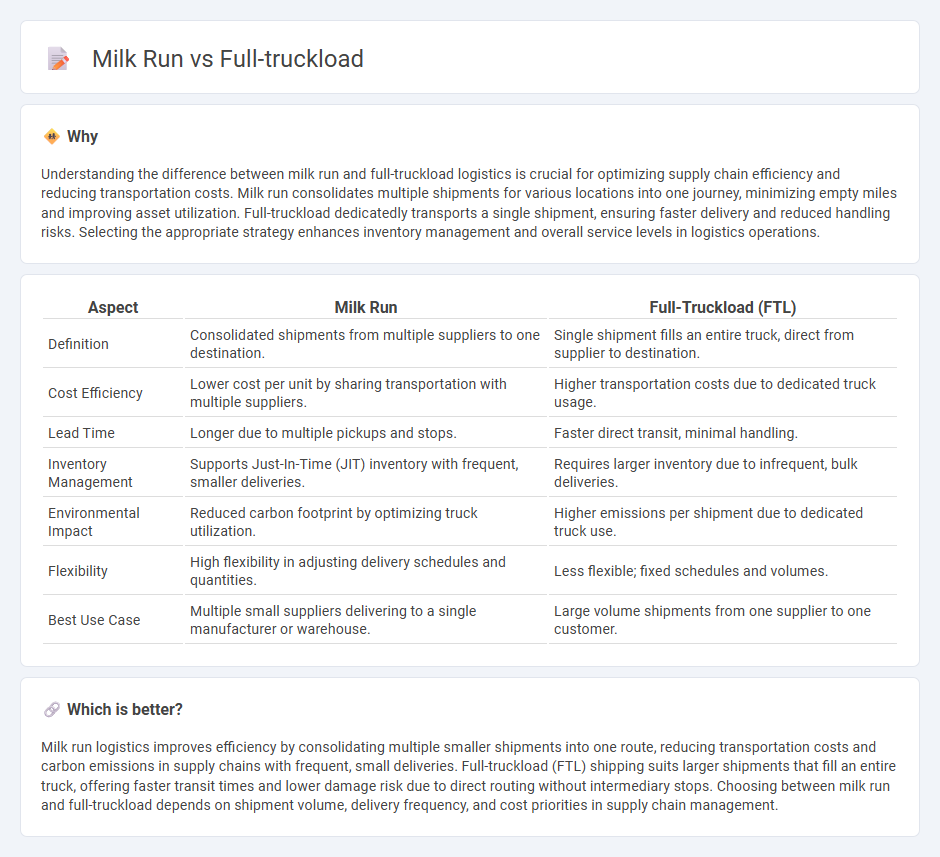
Milk run logistics optimize supply chains by consolidating smaller shipments from multiple suppliers into a single route, reducing transportation costs and minimizing inventory levels. Full-truckload (FTL) shipping, in contrast, involves transporting large quantities directly from one supplier to a specific destination, maximizing truck capacity and reducing handling times. Explore the differences between milk run and full-truckload strategies to determine the best fit for your supply chain efficiency.
Why it is important
Understanding the difference between milk run and full-truckload logistics is crucial for optimizing supply chain efficiency and reducing transportation costs. Milk run consolidates multiple shipments for various locations into one journey, minimizing empty miles and improving asset utilization. Full-truckload dedicatedly transports a single shipment, ensuring faster delivery and reduced handling risks. Selecting the appropriate strategy enhances inventory management and overall service levels in logistics operations.
Comparison Table
| Aspect | Milk Run | Full-Truckload (FTL) |
|---|---|---|
| Definition | Consolidated shipments from multiple suppliers to one destination. | Single shipment fills an entire truck, direct from supplier to destination. |
| Cost Efficiency | Lower cost per unit by sharing transportation with multiple suppliers. | Higher transportation costs due to dedicated truck usage. |
| Lead Time | Longer due to multiple pickups and stops. | Faster direct transit, minimal handling. |
| Inventory Management | Supports Just-In-Time (JIT) inventory with frequent, smaller deliveries. | Requires larger inventory due to infrequent, bulk deliveries. |
| Environmental Impact | Reduced carbon footprint by optimizing truck utilization. | Higher emissions per shipment due to dedicated truck use. |
| Flexibility | High flexibility in adjusting delivery schedules and quantities. | Less flexible; fixed schedules and volumes. |
| Best Use Case | Multiple small suppliers delivering to a single manufacturer or warehouse. | Large volume shipments from one supplier to one customer. |
Which is better?
Milk run logistics improves efficiency by consolidating multiple smaller shipments into one route, reducing transportation costs and carbon emissions in supply chains with frequent, small deliveries. Full-truckload (FTL) shipping suits larger shipments that fill an entire truck, offering faster transit times and lower damage risk due to direct routing without intermediary stops. Choosing between milk run and full-truckload depends on shipment volume, delivery frequency, and cost priorities in supply chain management.
Connection
Milk run and full-truckload (FTL) both optimize transportation efficiency in logistics by focusing on truck capacity utilization; milk run consolidates multiple smaller shipments into one vehicle route to reduce costs and improve delivery frequency, while FTL dedicates the entire truck to a single shipment to maximize volume and reduce handling. Combining milk run strategies with FTL can streamline supply chains by ensuring full truckloads are achieved through coordinated pick-ups and deliveries, minimizing empty miles and enhancing overall load optimization. This connection supports lean inventory management and reduces transportation expenses, crucial for industries requiring timely and cost-effective distribution.
Key Terms
Shipment Consolidation
Full-truckload (FTL) shipping involves transporting large quantities of goods directly from the shipper to the consignee, optimizing for speed and minimized handling. Milk run logistics consolidates shipments from multiple suppliers or locations into one truck, enhancing efficiency and reducing costs by maximizing truck capacity and minimizing empty miles. Explore how strategic shipment consolidation can transform your supply chain by balancing cost, speed, and reliability.
Route Optimization
Full-truckload (FTL) shipping involves transporting a single shipment that fills an entire truck, offering direct routes that minimize transit time and reduce handling risks. Milk run logistics optimize route planning by consolidating multiple smaller shipments from various suppliers into one truck, improving efficiency and reducing transportation costs through route optimization algorithms. Explore how advanced route optimization technologies can enhance your supply chain by balancing the speed of FTL with the cost-effectiveness of milk run strategies.
Load Utilization
Full-truckload (FTL) shipping maximizes load utilization by dedicating an entire truck to a single shipment, reducing handling and minimizing transit time. Milk run logistics optimize load utilization by consolidating multiple smaller shipments from various suppliers into a single truckload, enhancing efficiency and lowering transportation costs. Explore the benefits and challenges of both methods to determine the best strategy for your supply chain needs.
Source and External Links
Full truckload (FTL): Everything you need to know - Uber Freight - Full Truckload (FTL) is a shipping mode where the entire capacity of a truck or trailer is dedicated to a single shipment, ideal for large volumes and offering faster transit times due to direct shipping without stops.
A Shipper's Guide to the Full Truckload Market - ArcBest - FTL shipping involves transporting one shipper's goods in a single semi-trailer, providing benefits such as faster delivery and reduced handling, and is typically used when freight fills at least half a trailer.
Full Truckload | FullTruckload.com - Full Truckload shipping uses an entire truck for a single shipment, eliminating multiple stops for faster delivery, reduced handling, and increased security, making it suited for large, heavy, or time-sensitive cargo across USA, Canada, and Mexico.
 dowidth.com
dowidth.com